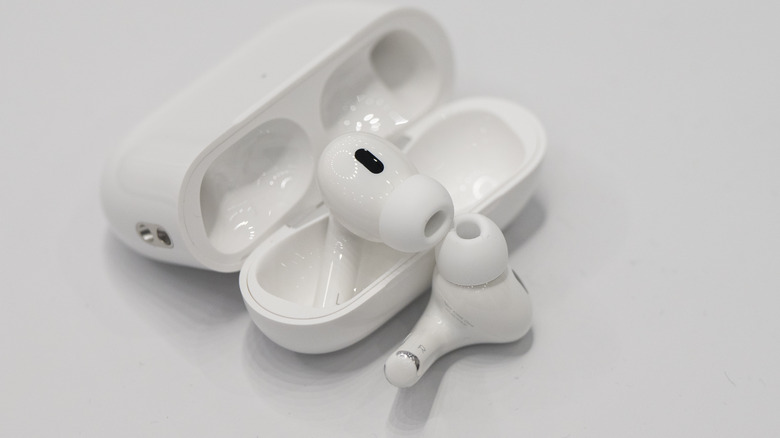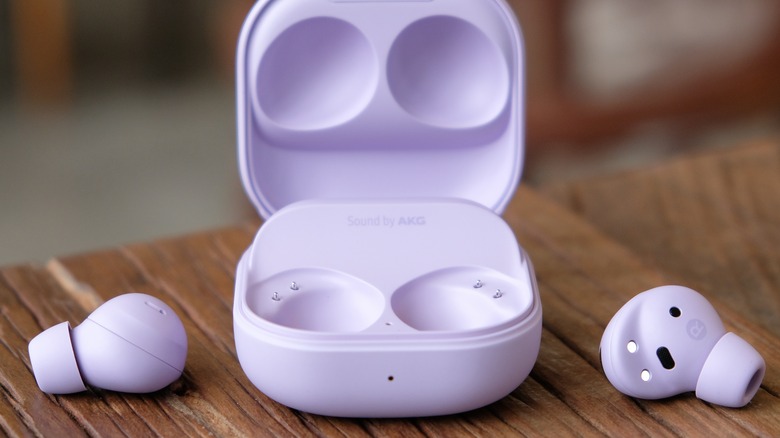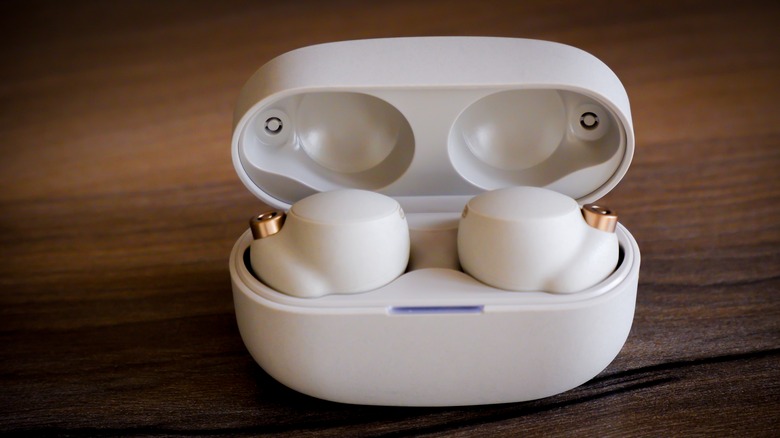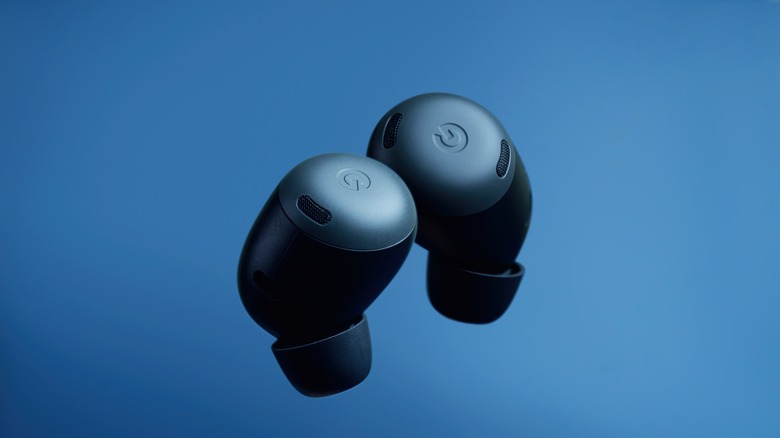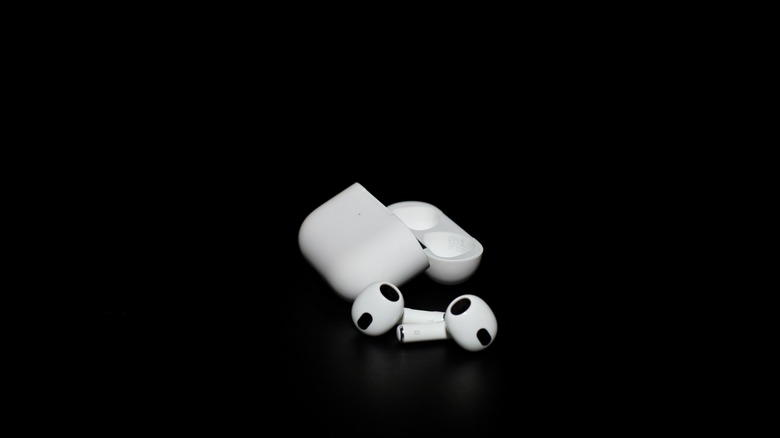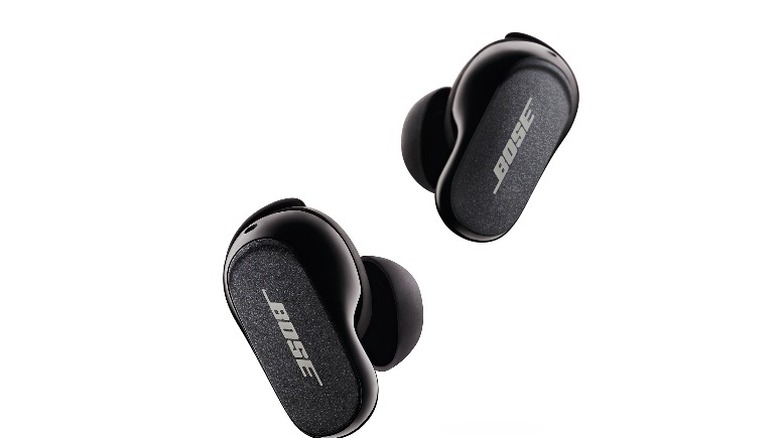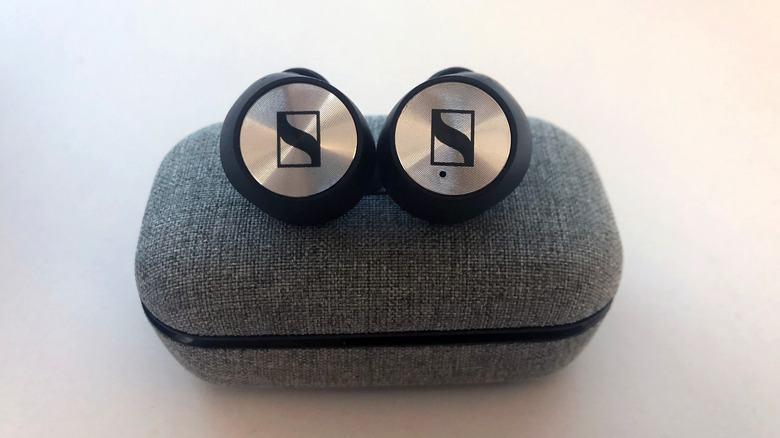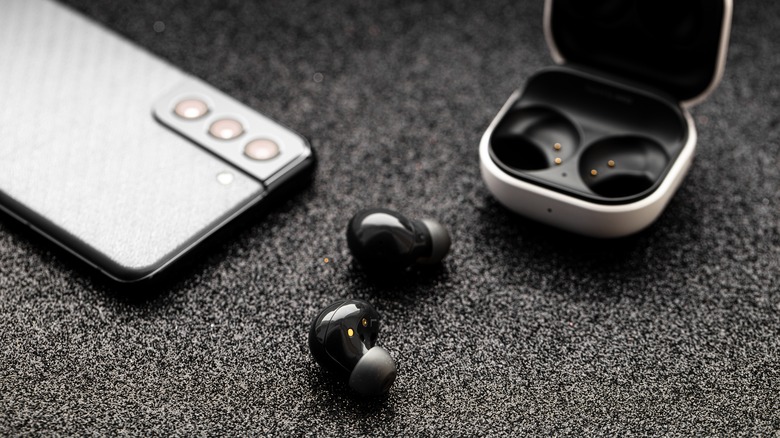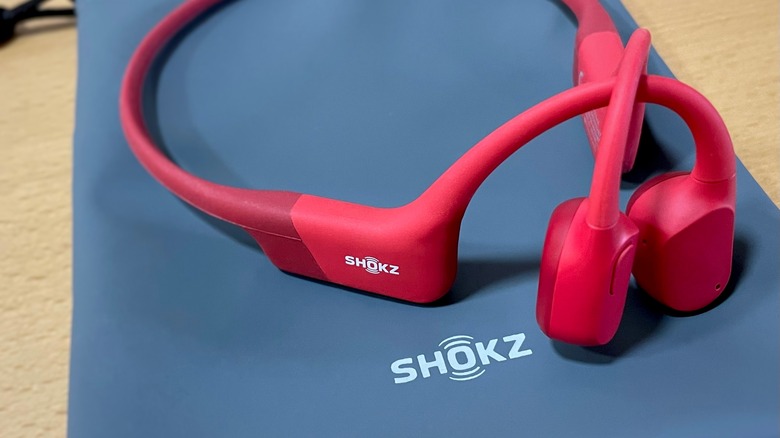The Best Earbuds Of 2022
2022 has seen its fair share of fantastic audio gadgets, especially earbuds. With improved active noise cancellation, better ambient noise control, stronger grip on the ears, and higher sound quality overall, this year's earbuds have caught the attention of consumers worldwide. Notably, more concept-design and high-niche earbuds — like the Shokz OpenRun Pro — have hit the mainstream market, exposing users to what could indeed be the future of sound.
All of this means that the use of earbuds is rising everywhere. The global earphone market is poised to exceed $33 billion in value by 2026 (via GlobeNewsWire), and earbuds will play a major role in this increase. This is due to the increasingly fierce market competition in the earbuds space. From well-known smartphone brands like Apple and Samsung to sound-focused companies like Bose and Sennheiser, scores of tech firms are looking to grab a slice of the pie.
Of course, wired earphones remain a preference for many people. They provide arguably better sound quality since they're directly connected to the source of the sound, do not have battery life limitations, and are cheaper by a mile. But wired earphones lack the flexibility of using wireless earbuds, cannot be used on phones without a headphone jack, are more prone to damage, and simply look out of fashion in 2022. Thus, if you're in the market for a new pair of earbuds or a replacement for your current pair, any of the following might fit your sound needs perfectly.
Apple AirPods Pro (2nd Generation)
When Apple released the first AirPods in 2016, consumers expected nothing but premium product quality from the brand. It had, after all, put the world on notice with the iPod several years earlier. Of course, it did so again with the AirPods — and again with the AirPods Pro. Indeed, Apple has continued to dominate the earbuds space in spectacular fashion. The AirPods Pro (2nd Generation) or AirPods Pro 2 feature major design changes and sound enhancements over the first-generation product that make them an easy first choice for millions of consumers.
Enabled by the Apple H2 chip for headphones, the AirPods Pro 2 feature both active noise cancellation and adaptive transparency, the latter of which allows users to remain attentive to ambient sounds while vibing to high-quality music. It also offers Spatial Audio and Head Tracking, both of which give the sensation of a cinematic surround sound to the listener. With up to 6 hours of battery life on a single charge (and 5.5 hours using Spatial Audio), the AirPods Pro 2 is one of the longest-lasting earbuds on the market. While using the MagSafe charging case — which is itself powered by the Apple U1 chip — a user can enjoy up to 24 hours of talking and 30 hours of listening. As one might expect from Apple, the AirPods Pro 2 are highly integrated with other products in the Apple ecosystem, so much so that they have Siri-enabled functionality in addition to basic shortcuts. The downside to that is their functionality is limited when paired with an Android device, so we can really only recommend them for iPhone-carrying customers.
Samsung Galaxy Buds 2 Pro
Speaking of ecosystems, it's safe to say that Samsung has taken another page from Apple's playbook. The Samsung Galaxy Buds series join forces with the Galaxy Watch, Galaxy Tabs, and Galaxy smartphones (like the Samsung Galaxy S22 Ultra) in providing Samsung users a level of tech-enabled completeness that only a few companies can match. In particular, the Samsung Galaxy Buds 2 Pro are a significant jump from the Samsung Galaxy Buds Pro. Their upgrades in battery life, Bluetooth connectivity, active noise cancellation, and more make it a truly desirable product for target users and a tough competitor for the AirPods Pro.
The major selling point of the Galaxy Buds 2 Pro, and its first mark left on users, is its ergonomic design. With a 15% reduction in size from the Galaxy Buds Pro, the earbuds of the Buds 2 Pro fit comfortably in the ears and are not likely to fall with user movement. They are also water resistant, with an IPX7 rating; offer active noise cancellation, with ambient sound allowance; and can play continuously for up to eight hours with the noise cancellation off and five hours when on.
The Samsung Galaxy Buds 2 Pro function excellently well with other Samsung products. Features such as Bixby Voice Wake-up and Auto switch allow for an increased level of dynamism with the Buds 2 Pro. With SmartThings Find, users can easily track and locate the earbuds — and even set up a notification that informs them when they move away from the Buds 2 Pro.
Sony WF-1000XM4
Over the years, Sony has built a reputation for the sound quality of its audio products. The company has maintained this prestige in the WF-1000XM4. But even more, Sony's earbuds have been built to directly rival the AirPods Pro and any other top earbud contender out there. The WF-1000XM4 feature Sony's in-house LDAC coding tech, allowing users to stream audio at up to 990 kbps — which just blows the conventional 128 kbps and 256 kbps audio streaming rates out of the water. With earbuds this good, consumers would only be left wishing that the product name was as memorable as the audio quality is superior. Not that this would stop them from buying, though.
Just like its LDAC, the Sony WF-1000XM4 earbuds also feature excellent active noise cancellation combined with good ergonomics, in both size and design. They are lighter and smaller than their predecessors, the WF-1000XM3 earbuds. The ear tips, which come in different sizes, have been redesigned for better grip in the ears. The WF-1000XM4 earbuds allow for up to 6 hours of communication time and 12 hours of playback time, both with noise cancellation off; turning on the noise cancellation would reduce these maximums to 5.5 hours and eight hours respectively. There is also an ambient sound mode, which works like the adaptive transparency feature on the AirPods Pro 2. Plus the best part: the WF 1000XM4 can be charged from zero to full in just 90 minutes.
Google Pixel Buds Pro
Given the fierce competition and market interest in earbuds, it's no surprise that even Google would jump on this train. The company is still new in the earbuds space relative to major market players like Apple. But with the Pixel Buds Pro, Google isn't just trying to tag along; it's already rivaling these major players.
The Google Pixel Buds Pro sports a remarkable ergonomic design that's characteristic of Google's tech products. At a weight of 6.2 g, the Pixel Buds Pro is designed to fit properly into the ears and comes with ear tips of various sizes. The earbuds are sweat and water-resistant, rated at IPX4 with the Buds Pro case rated at IPX2. Speaking of the case, there's support for Qi wireless charging as well as a USB-C charging port.
Furthermore, the experience of using the Pixel Buds Pro is simply delightful. Google offers a slew of smart options, including capacitive touch — which lets the listener control the volume and playback using tap-and-swipe gestures. As is common with many other 2022 earbuds, the Pixel Buds Pro has a solid active noise cancellation feature, in conjunction with a transparency mode. In terms of battery life, the Pixel Buds Pro does not fall behind either: seven hours standalone and 20 hours with the charging case, when active noise cancellation is on; 11 hours standalone and 31 hours with the charging case, when active noise cancellation is off.
Apple AirPods (3rd Generation)
While shipping the top-level AirPods Pro series, Apple has continued to iterate on the AirPods, as this base variant remains the preferred option for a share of the market. Moreover, the spec differences between the AirPods 3 and AirPods Pro 2 are not so large as to render the AirPods a poor-value product for its $179 starting price. The AirPods run on Apple's H1 headphone chip, providing a talk time of up to 4 hours and a listening time of up to 6 hours. With Personalized Spatial Audio and Head Tracking, each earbud also houses several sensors for motion detection, skin detection, and speech detection, increasing the use cases of the AirPods beyond merely listening to music. In addition, the AirPods is water and sweat-resistant, offers a MagSafe charging case option, and works with Siri commands like the AirPods Pro.
Old Apple product users would love the fact that the AirPods are compatible with iPhone models all the way back to the iPhone 6s Plus and iPad models dating back to the iPad Mini 4. The caveat, though, is that certain features like Audio Sharing — where two AirPods can be connected to the same audio source — do not work on older phones. Audio Sharing also does not function with Android products, although they can be used with AirPods. Without question, the only way to enjoy the entire suite of features offered by the AirPods is to have an Apple product with the latest operating system (OS) version.
Bose QuietComfort Earbuds II
There's a good chance that the "QuietComfort" moniker already gives off the major selling point of this pacesetting pair of earbuds. If it's not already obvious, that selling point is noise cancellation. Bose has already solidified its reputation as an industry leader in noise cancellation tech, and the company has taken things a step further with the Quiet Comfort Earbuds II. The first-generation Quiet Comfort Earbuds were already the cream of the crop, so it's exciting to note that Bose one-upped that product in just two years.
The Bose QuietComfort Earbuds II also features what the company has tagged "CustomTune technology", which works by adapting the sound to the shape of your ear canal. Made of hard plastic and a silicone ear tip, the buds are sweat and water-resistant, at an IPX4 rating. Its lithium-ion battery allows for up to six hours of battery life, with zero to full charge in 60 minutes. The buds have a Bluetooth connectivity range of up to 30 ft and each earbud houses four microphones for top-level sound quality in calls and meetings.
It's also awesome that the Bose QuietComfort Earbuds II works on all smartphone types, with no feature restrictions whatsoever. Plus, the Bose Music app gets users started easily with the earbuds and can be used to configure gestures and voice commands on the earbuds. At a relatively high cost of $279, the Bose QuietComfort Earbuds II is worth every penny of its price tag.
Sennheiser Momentum True Wireless 3
The Sennheiser Momentum True Wireless 3 (MTW3) might be a pricey pair of earbuds, but a few minutes of use immediately confirms why. The company has thrown its full might into providing superior audio quality, and while its noise cancellation might not be as great as that of the AirPods, it still attracts consumers more concerned with the actual sound. The Sennheiser MTW3 earbuds were configured with Sennheiser's in-house aptX Adaptive audio coding tech which, according to the company, feeds your ears with every single sound detail in the audio. For listeners who love to play with sound features, there's also an equalizer to manipulate bass and treble levels.
As opposed to the active noise cancellation on the AirPods and several other earbuds, the Sennheiser MTW3 employs Adaptive Noise Cancellation. Adaptive Noise Cancellation is similar to active noise cancellation, but it can adjust the levels of noise cancelation based on the amount of noise in your environment (via Yugatech). Shipping with ear tips of various sizes, the MTW3's excellent fit in the ears is worth mentioning. The earbuds are also housed in a case that can be charged wirelessly, in addition to allowing up to 28 hours of playback time.
Sony LinkBuds
The Sony LinkBuds offer a truly unconventional design. To put it simply, Sony took a different, design-based approach to allow for ambient sound without featuring noise cancellation. The design? Attach a donut-shaped hole to the main earbud body, and have the earbuds filter in ambient noise through that hole. The Sony LinkBuds may be an example of the company's openness to experimentation, but they also illustrate that Sony is willing to focus on the real-world implications of using earbuds rather than just packing features that make the product look premium.
Despite the donut hole attachment, the Sony LinkBuds have an admirable design, remain light and tiny, and fit completely in the ears. With an IPX4 rating, they are also water and sweat-proof. Sony has implemented a machine learning algorithm in the LinkBuds to allow for sound adaptiveness, whereby the volume of the earbuds increases or decreases according to the loudness of ambient sound. The same applies to phone calls, as the earbuds douse environmental noise and redirect the focus to the discussion at hand. The Bluetooth covers a range above 30 feet, and the Sony LinkBuds allow for up to 5.5 hours of listening time on a full charge.
Users who find the Sony LinkBuds unfit for their preferences, especially due to its lack of noise cancellation support, may love the Sony LinkBuds. Though more expensive, the Pro-level LinkBuds offer more features that make it likely to be perceived as an in-house competitor to the WF-1000XM4.
Samsung Galaxy Buds 2
For Android-based earbud users on a budget, the Samsung Galaxy Buds 2 might just be the right choice. Though not as premium as the Galaxy Buds 2 Pro, Their noise cancellation, high-quality audio, and great Bluetooth range mean that they offer great value for money — at a starting price of $150. The Samsung Galaxy Buds 2 make a major design improvement from their predecessor, as Samsung replaced the triangular touch section with an oval shape rounded at the top. Samsung also touts the Galaxy Buds 2, as the lightest buds ever made by the company at just 5 g. In Samsung's words," You may get to the end of your playlist before you remember you're wearing them at all."
But you certainly won't get to the end of your playlist before stopping to appreciate the array of usability features on the Galaxy Buds 2. This pair of earbuds offer active noise cancellation, which is a first for Samsung on its base-variant buds, in addition to three levels of ambient sound allowance. With a 61 mAh battery, the Galaxy Buds 2 will last for five hours of playback when noise cancellation is on and 7.5 hours when noise cancellation is off. Samsung has maintained its ecosystem philosophy with this product, as it supports Bixby commands, can work with the Galaxy Watch, and is configurable through the Samsung Galaxy Wearable application.
Shokz OpenRun Pro
Remember when we wrote that more concept-design and high-niche earbuds have hit the market? This is one accurate example. The earbuds maker Shokz has a better idea than listening to music directly through the ears. Its product, the Shokz OpenRun Pro, is a "bone-conduction" set that takes audio technology to a new level while offering users a remarkable listening experience.
The Shokz OpenRun Pro do not share design and usability features with many other earbuds — they actually fall more into the "headphones" category than earbuds. But we included them on this list because their compact nature might appeal to those of you who are shopping for a pair of earbuds. Plus, these $179 headphones sell a philosophy of excellence in bone-conducted music. Sporting a well-thought-out design, the OpenRun Pro headphones offer up to 10 hours of listening and talking time. And with what the company calls its 9th Generation Bone Conduction Technology, The Shokz Open Run Pro is also resistant to water at an IP55 rating.
Since the Shokz OpenRun Pro is an upgrade from the previous Shokz OpenRun, it's not out of place to assume that the company will be moving in this direction going forward. The market will observe as they do so, and bone conduction might be at the core of earbud technologies in the next few years. When that time comes, the world will look back favorably on Shokz for pushing in this direction on a seemingly lone race.

